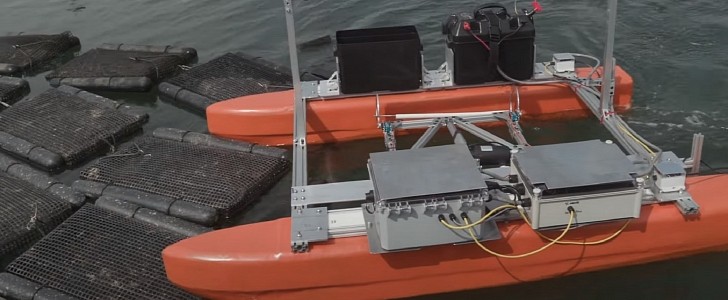Oyster farming is a high-maintenance job that entails constant work. Flipping the mesh oyster bags is one of them, and it's a dull, exhausting task that is also costly and risky. But the Oystamaran robotic catamaran might put a stop to all that, aiming to automatize the aquaculture industry.
All the thousands of floating oyster bags have to be turned more than 10 times a year according to Michael Triantafyllou, director of MIT Sea Grant. This way, oyster farmers make sure the water flow to the oysters is not blocked, preventing their healthy growth, and algae, barnacles, and other organisms that grow on the bag are exposed to air and light.
But this is an unpleasant task which is normally performed manually, from kayaks, and farmworkers have to cope with bad weather and rough waters. It is often hard to find people who want to do that, and it's an expense of a few thousand dollars per year.
A team of students and researchers from MIT (Massachusetts Institute of Technology) is working on a robot that can take over the job and can flip the oyster bags instead. The Oystamaran is described by its developers as a first for the industry, proving that robots can perform useful tasks in the ocean. Its creators hope it will serve as a model for future innovations in aquaculture.
While the machine is currently controlled remotely from the shore, the goal is to make the vessel autonomous, being able to navigate on its own, flip the bags, and then return to the launching point.
Right now, the electric, self-propelled floating device comes with a flipping mechanism like a robotic arm between its two hulls, which helps it grab the bag, lift it and then flip it over. Eventually though, MIT's Oystamaran will combine navigation with visual technology to be able to locate the oyster bags by itself using cameras, then get to them and flip them.
But this is an unpleasant task which is normally performed manually, from kayaks, and farmworkers have to cope with bad weather and rough waters. It is often hard to find people who want to do that, and it's an expense of a few thousand dollars per year.
A team of students and researchers from MIT (Massachusetts Institute of Technology) is working on a robot that can take over the job and can flip the oyster bags instead. The Oystamaran is described by its developers as a first for the industry, proving that robots can perform useful tasks in the ocean. Its creators hope it will serve as a model for future innovations in aquaculture.
While the machine is currently controlled remotely from the shore, the goal is to make the vessel autonomous, being able to navigate on its own, flip the bags, and then return to the launching point.
Right now, the electric, self-propelled floating device comes with a flipping mechanism like a robotic arm between its two hulls, which helps it grab the bag, lift it and then flip it over. Eventually though, MIT's Oystamaran will combine navigation with visual technology to be able to locate the oyster bags by itself using cameras, then get to them and flip them.







